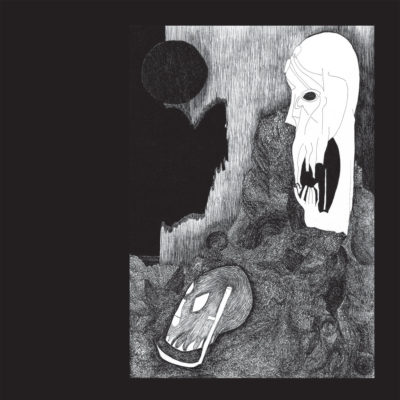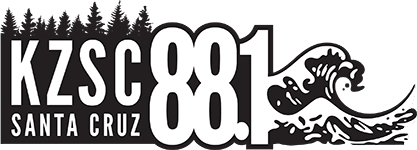
Two Sundays ago, on the 23rd of last month, I had the opportunity to interview Wrekmeister Harmonies at The Crepe Place before their set that night. Wrekmeister Harmonies is JR Robinson and Esther Shaw, an experimental project that mixes elements of doom metal, post-rock, and noise music. Their most recent album, Light Falls, was released in September of last year.
K: How has your tour been going? I read on your Facebook page that you performed with Aesop Dekker two days ago, how did that go?
JR: It was great. He is in a great band, Worm Ouroboros. Aesop is a very, very funny man.
K: He’s funny?
JR: He’s very funny, he’s very short, and I like him a lot.
K: Anyway, so for your recorded material, in the creative process how much improvisation do you incorporate? I know you worked with three members of Godspeed You! Black Emperor on the new record Light Falls, did they introduce any of that sort of spirit in the recording?
JR: Well they’re members of Godspeed so it’s gonna sound like what half the members of Godspeed is gonna sound like, and we kind of knew that going into it. We didn’t come up with any set directions for them, we just had some stuff written and thought ‘this will probably sound interesting if we play it with these people’ and that’s kind of how it all went down. It was very easy, very organic, very pleasant–they’re nice people.
K: So you just had some written framework going into it?
JR: [To Esther] We put together a set of scaffoldings, wouldn’t you say?
E: Yeah, we also toured on it. We played a few shows with some of the ideas we had just to flesh things out. Then when we got there, we played some of that stuff and just kind of built on it.
K: Since the beginning of the tour, would you say that working with material from the new album, performing it live, has helped you process and understand the themes and the personal meaning that you’ve put into the album?
JR: No, all of that, all of those feelings and all of the processing happens during the creation of it and then the capturing of it. Then after that’s done it’s just a matter of how we’re feeling that particular night. I’m sure your mindset changes from day to day, you’ve probably made some things in your life and you’ve looked at them and said to yourself ‘I made this, I was in a particular frame of mind at that time’ and then perhaps you show it to people and but you don’t try and rebuild it or tear it apart and rebuild it every single time, you just show them what you made.
Some days you take your friends back to show them a thing you made and you’re in a particularly explanatory mood and you’re talkative that day, perhaps you’re inspired to talk about it; and maybe another day you’re kind of tired because you’re a member of the human race, people get tired, and you don’t want to show that much, that also is part of it. So there’s not a lot of processing going on in the live part of it.
E: And I think that’s also why when we perform off of an album we’re often adding in new pieces as well, because we’re always looking forward to building something new again and there’s something on the horizon for us in a way so it’s gotten us performing old stuff and then also playing around and starting something new as well.
K: Like working out new ideas live, perhaps bringing them to a recording later?
E: Exactly. Like tonight’s going to have pieces of Light Falls and also stuff we’ve been just recently working on as well that we’re just fleshing out.
K: On Light Falls obviously you had more musicians than two on it, I’m really curious as to how that will translate to two members. I mean obviously I’ll find out watching it but–
JR: I think with the newer material the static droning things are on the edges, working their way in, rather than it being the center and things coming out of it. So that for us is a very intuitive and easy process for the two of us to do together, it’s very exciting to try and do it, keep developing it night after night.
We play “Mantra” and that’s something that we came up with on our own anyway and we’re always very comfortable playing that on our own so that hasn’t really changed and I think the inherent message of it is not diluted any by the subtraction of band members playing it. It’s a very personal meditation that we’re putting out. So basically all we’re doing is distilling it down to the essence of the song itself. With just Esther and I, I think we’re really able to crystallize that message down to its essential elements.
K: So basically the song at its core, its true essence, can still be created with two members.
JR: You’ll find out tonight, but I think we do a very good job of covering a lot of sonic ground. We’ve been really working this past year and a half on developing a reliance on each other to build these pieces and to cover a lot of frequencies. A lot of moods, a lot of textures, and a lot of personal feelings. And to not rely on other people, to just do it on our own is very important.
K: I’ve noticed with live bands that just have two members, I think sometimes people underestimate just how much sound they can produce, how much powerful it can be to have just two members in a band, especially with heavier music too.
JR: I think you could say there’s a certain inherent power of seeing one hundred musicians all striking a C major chord at the same time, that’s going to have an impact. I’ve also had one person just devastate me with their emotional output, so it’s all about personal feelings, do you have an idea, do you have a feeling and an emotion that you’re trying to communicate. Are you experiencing something inside that you’re trying to express, that you’re trying to get from here to the outside world. You can use thirty people, you could use a hundred people, you could use one person, you could use two people, as long as you have a true emotion, a true feeling that you’re trying to communicate, then I think that’s a good thing.
And it can’t be denied–if somebody is actually truly trying to communicate an emotional state to you, and they’re doing their best to do it, it’s hard to ignore. Conversely, if somebody is going through the motions, if you’ve got a group of people, one or two individuals, or a hundred people, they’re just kind going through the motions–‘I got stuff to do, I gotta get up and do my thing tomorrow, I’m hungry, I’m bored–‘ that is just as easily observable, right?
E: I think the chances of that happening increases with the more people you have, because you can’t really control focus as easily as more and more people are added to a group in that way. But when it does work out it’s really powerful. I was just thinking that some of the most amazing shows I’ve seen have had one person. I remember we saw Kevin Drumm perform at the Cultural Center in Chicago–there were these really high ceilings, he was making some amazing sounds and allowing people to walk through the room and explore the sound and that in itself was very impactful and extremely noisy, exploring lots of frequencies.
K: I mean undeniably with less people it’s probably easier to find solidarity in a single emotional feeling or message.
JR: Well you don’t have to adopt the other people’s psychological makeup of that particular moment. Esther and I are very in tune with each other and when you get more people involved you have to adapt to their particular mindset, like perhaps they’re not having a great day, and say they’re going to project that into the environment. So then also you have to deal with that, and maybe that’s not going to be so beneficial to what you’re trying to communicate, whatever you’re trying to express to the world.
Maybe this person over here is throwing up a wall, giving you a hard time, or experiencing some mood cycle that is foreign to you, but it’s affected you. And so how are you going to communicate your idea that is very important to you, without having some residual effect from that?
K: I would probably just absorb this unknown feeling if I cared about working with that person and I–
JR: –But then your original idea is run through a filter of that person’s psychological profile.
K: If I felt like I was the sole creative leader in a music group, I would probably feel uncomfortable with incorporating that or as you said ‘filtering’ myself through that, if that was completely alien to me and to my vision. But I think if we both, or maybe it was multiple people experiencing all kinds of different things, I would try, at least at first if it even worked, to absorb their emotions.
JR: It takes a lot of energy to tell this person I want him to behave this way, I want that person to behave a different way, I want only the things that I want–I’ve done that. And I’ve done that in situations where it is really easy, where I know that this person is going to give me something, I know exactly what I want, some I’m going to go in, I’m going to get what I want, and our interaction and our experience together is limited to this very specific thing. It’s fine I guess, I get what I want, but it’s hard to keep repeating that process over and over and over again. And that’s something I’m not interested in.
K: Because it takes a lot of energy.
JR: Because it takes a lot of energy. It takes a lot of time, a lot of energy.
K: So that’s why it may be easier to perform live just with Esther.
JR: Definitely. But when we do play with a band or other people–
E: –It’s also rewarding in it’s own way too. Like what I was saying before when it does work out, it’s really impactful, and we’ve met many people where it does work out really well and we’re lucky that we made the collaboration, and it takes a lot of energy but there’s also great rewards for that as well.
K: So obviously over time, people change, personalities change, and as that happens, music happens. How do you feel as a musician specifically, you have changed since before Wrekmeister Harmonies began to now?
JR: I think the changes have been pretty profound. Since we started off, it’s been more of an art-focused project into doing more sound design in museums and evolving into kind more of an experimental, noisy kind of thing and moving into heavier music from there, and then stepping up and performing with thirty different musicians to make one piece of music, and then stepping down to five people, and then stepping down again to two people. I think it’s a logical extension, if you’re going to be an artist, to continue to evolve and challenge yourself. Don’t make the same thing over and over again, continue to grow and evolve. I feel like once I start repeating myself, that’s something I really loathe. Because to me, personally, it’s not valid, it’s not a valid statement.
K: And if it’s not valid, then it’s not worth sharing.
JR: Why do it, what’s the point? To show off my technical prowess? I don’t have it [laughs] it’s not what I have, it’s not my strong suit, it’s not my technical ability.
K: Going into it from the beginning of Wrekmeister Harmonies did you ever imagine doing sound design in museums and stuff?
JR: How that came about is I just had this idea once, I was at a Dan Flavin exhibit, light sculpture, people walking through this light, and I thought ‘what would happen if I projected certain tone fields, project that into a space and have people walk through them, and record the results of how that changed?’ And people seemed to be into it, curators seemed to be into it. So I got to go around the world and do that for a while. But what was I going to do, continue to do the same thing in museums? I didn’t want to do that, I wanted to do something else.
K: From the beginning was metal always something that you kept as an influence?
JR: Yeah, definitely. That music just represents a certain type of emotional statement. Metal is one way of expressing a certain feeling. It’s very good at conveying a sense of intensity, anger, frustration, loneliness, dissociation, dislocation. All of these things are very well represented by metal. And I remember as a very small child being exposed to heavier music, like Black Sabbath, Blue Cheer, stuff like that early on. So I don’t think it was ever not a part of my life.
K: Well thank you very much for letting me interview you today, I’m excited to see you perform tonight, and I’m glad that you’re putting this type of music into the world.
JR: And we’re glad that you’re glad.
K: Yay!
JR & E: Yay!

